Column: L.A. homeless crisis grows despite political promises, many speeches and millions of dollars. How do we fix this?

L.A. Times columnist Steve Lopez roams Greater Los Angeles with Times photographer Francine Orr and videographer Albert Lee and describes a scene of despair among the homeless.
- Share via
It was another warm January day, the afternoon sun sailing across a blue sky, the air thick with the scent of urine, rotting trash and human misery.
Beginning at Central Avenue and heading west, I counted 16 tents on the south side of 5th Street. My longtime traveling companion, Times photographer Francine Orr, counted 15 tents on the north side of the street.
One block, 31 tents.
On skid row, this is the norm, and it has been for years. On a recent day, it was not possible to walk on the sidewalk in the one-block stretch of 6th Street between San Julian and Wall streets. Rows of tents and blue tarp shanties lined the entire stretch, extending all the way to the curb, so you had to walk in the street.
I spent quite a bit of time in this area 13 years ago, when Orr and I first covered skid row and the thousands of homeless people who lived there. Back then, I never got past a sense of disbelief that this could exist, without an immediate crisis response, a few blocks from the halls of power and the towers of success.
I recall the two prostitutes who conducted business in port-a-potties at the corner of 6th and San Julian streets, just a block from the police station. I recall the wheelchair brigades, the haunted faces of those tortured by mental illness, the cruising drug dealers and the heroin addict who died of an overdose before our eyes in the ambulance on the way to the emergency room.
I recall former Los Angeles Police Chief Bill Bratton calling it “the worst situation in America.”
But millions of tax dollars and dozens of speeches and political promises later, the situation is no better.
“It’s worse,” Orr said as we counted tents and people — the unemployed, the addicted, the sick, the destitute.
But what’s most alarming is that we have a growing constellation of skid rows across greater Los Angeles, from Burbank to Bel-Air and Pasadena to Pacific Palisades. Los Angeles, rich beyond dreams, is a refugee camp, its riverbeds and alleys draped in blue tarpaulin.
So here is my question — a question that taxpayers, merchants, sympathetic observers, disillusioned critics and the homeless themselves have every right to ask:
When, if ever, will the situation get better?
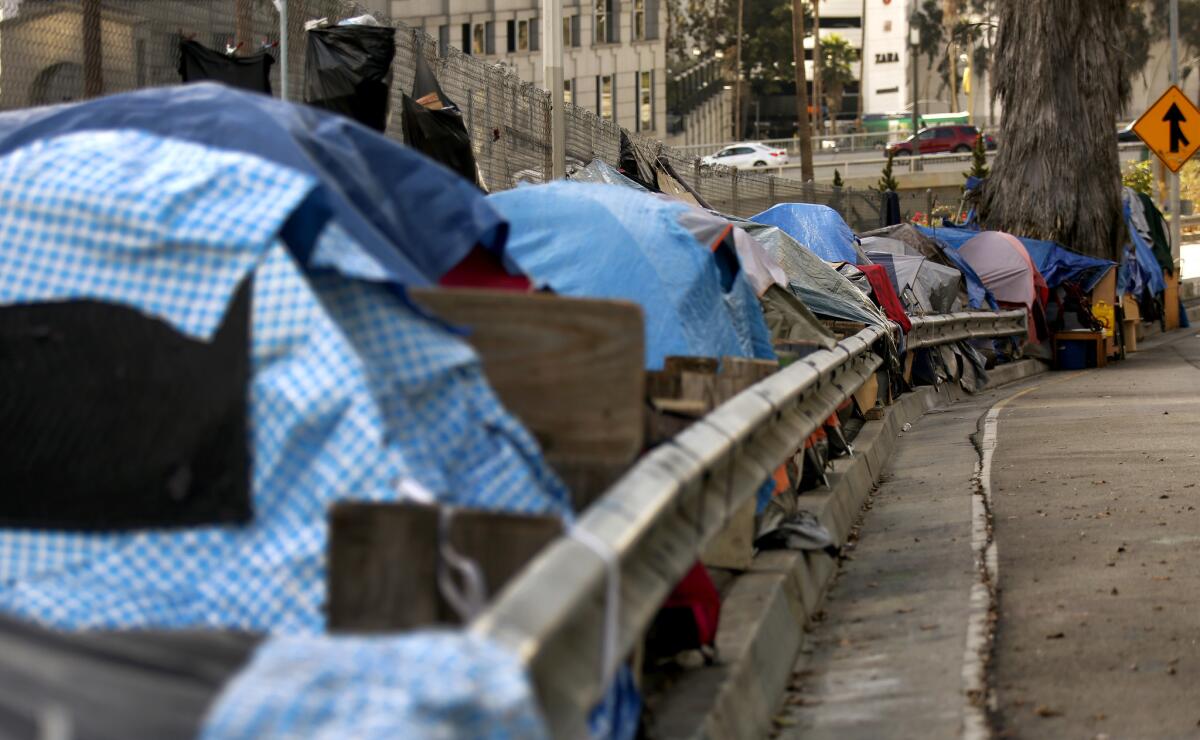
“We can bring these numbers down,” Los Angeles Mayor Eric Garcetti said in 2016, when the county’s homeless number rose to 47,000, with 28,000 in the city alone. “This could be the year that we bring the numbers down.”
Can and could.
But didn’t.
Here we are now in 2018, hopes dashed, and this could be the year Garcetti’s presidential pipe dream ruptures under a shantytown in the homeless capital of the United States.
To understand why Los Angeles always seems to be playing catch-up, you need to go back to a time when there was open contempt and little cooperation between city and county officials, and little in the way of comprehensive planning or coherent execution.
It was not even known, until 2015, how much the city of Los Angeles was spending to curb homelessness. The answer, contained in a blistering report from the city administrative officer, was more than $100 million. But the money was not well spent.
“There appears to be no consistent process across city departments for dealing with the homeless or with homeless encampments,” said the report by City Administrative Officer Miguel Santana, who added that the city was managing rather than solving the problem.
Things have changed for the better since then, especially on the cooperation front, with Garcetti and L.A. County Supervisor Mark Ridley-Thomas working closely together.
When I called the mayor a few days ago to talk about the slow slog, Ridley-Thomas joined him on the line, and both argued that they have never worked harder on this issue, from championing bond measures and building more housing to finding better formulas for homeless prevention.
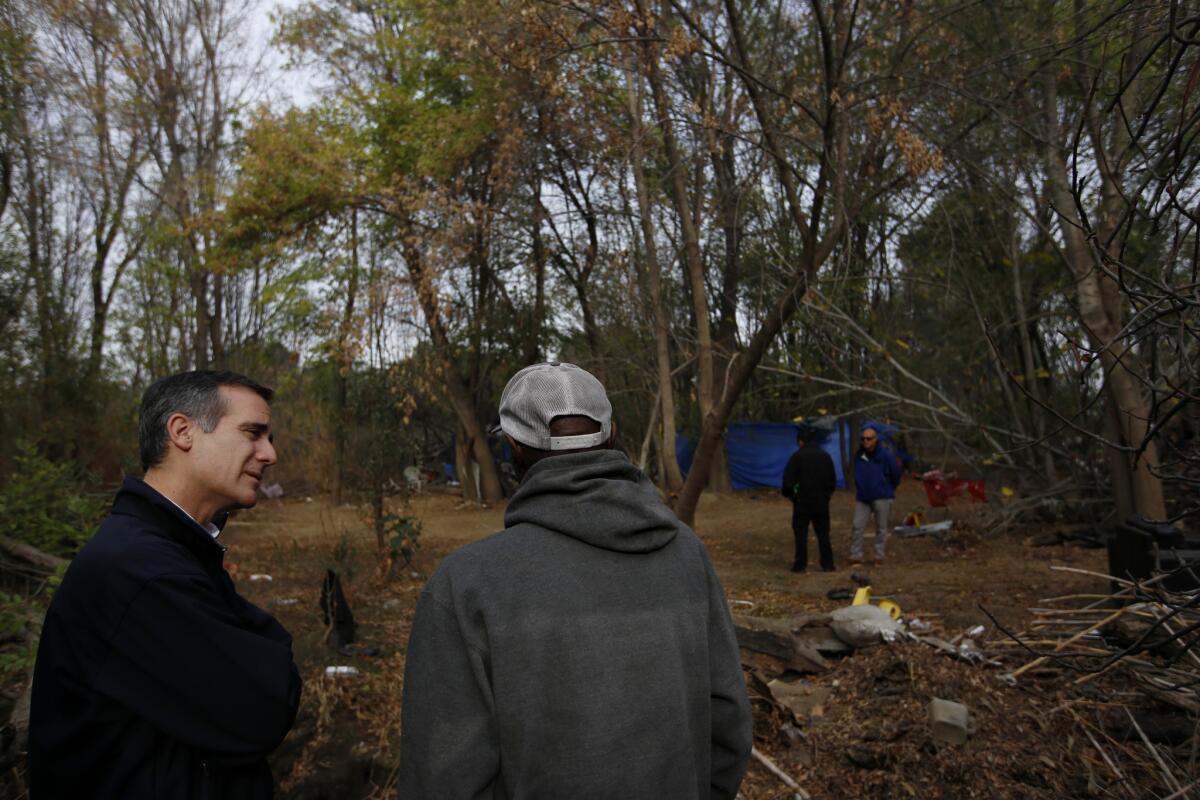
Garcetti said he doesn’t see failure; he sees progress and hope.
“There’s never been a point,” said Ridley-Thomas, “where I’ve seen more energy, more focus and more resources aimed at this crisis, and it is a crisis.”
For all that, Ridley-Thomas said, local officials got a late start.
“The real problem is that we were not proactive enough in the face of what might very well be described as an onslaught,” the supervisor said. “We just didn’t make it the kind of priority it needed to be.”
But that isn’t the only problem.
For all the progress that’s being made, some frustrated homeless advocates still see a disjointed silo system, with various city and county agencies forging ahead independently, with no unifying structure or clear leadership. I can’t tell you how many times I’ve heard people in the system groan about the confounding difficulty of getting simple things done, thanks to jurisdictional boundaries and bureaucratic impediments.
The Los Angeles Homeless Services Authority is a joint city-county agency that manages money and projects. But it’s more of an administrative body than a policy and strategy concern, the way, say, the Metropolitan Transportation Authority board governs regional transportation issues.
Ridley-Thomas said he thinks it’s time for a change. The homeless authority was established 25 years ago, he said, when the needs were different.
“That structure is not well suited for what we’re dealing with,” Ridley-Thomas said, adding that there’s a growing consensus on that.
Garcetti agreed that an agency with more authority is needed, possibly with elected officials as board members, as in the MTA model.
“I’d gladly give it the authority to jointly coordinate housing, law enforcement, sanitation, health and human services,” he said.
That might help, because both the city and county now have detailed long-term strategies, but there’s no buck-stops-here authority.
Taxpayers have stepped up, and have a right to expect more progress. City residents approved Proposition HHH in 2016 to generate $1.2 billion for new housing over 10 years. A few months later, county voters approved Measure H, which will produce about $350 million of services each year.
But this brings us back to the central question of when and whether we’ll see any progress or be lucky to maintain status quo. After all, it’s not as if the number of homeless people is finite, especially not in a region where housing costs have soared and gentrification has unsettled one neighborhood after another, pushing more people into their cars and onto the streets.
On skid row, I asked a social worker if numbers are up.
Yes, he said.
And what’s the biggest reason?
“Evictions,” he said.
“HHH contemplated building 10,000 units over 10 years,” said Philip Mangano, former homeless czar for President George W. Bush and chief executive of the American Round Table to Abolish Homelessness. “That’s 1,000 units a year, but we know from data that you have way more than 1,000 people coming through the front door. So you’re not even bailing a leaking boat.”
I first met Mangano in 2006 at a skid row news conference at which local leaders dramatically unveiled a plan to end homelessness in 10 years. A few years later, with major objectives unmet, yet another plan was rolled out.
Over the years, thousands of housing units have been built and many, many people rescued and rehabilitated. There is no denying those successes. But demand has repeatedly swamped supply, and goals have remained out of reach. All the while, sensible housing projects have been stalled or abandoned because residents — despite voting for more housing — have opposed any such developments in their neighborhoods.
Last year, for instance, a plan to convert a motel near Temple City into supportive housing for veterans and formerly homeless people was derailed when hundreds of residents objected, raising fears of skid row conditions.
“We won the war,” said a representative of San Gabriel Valley Concerned Residents.
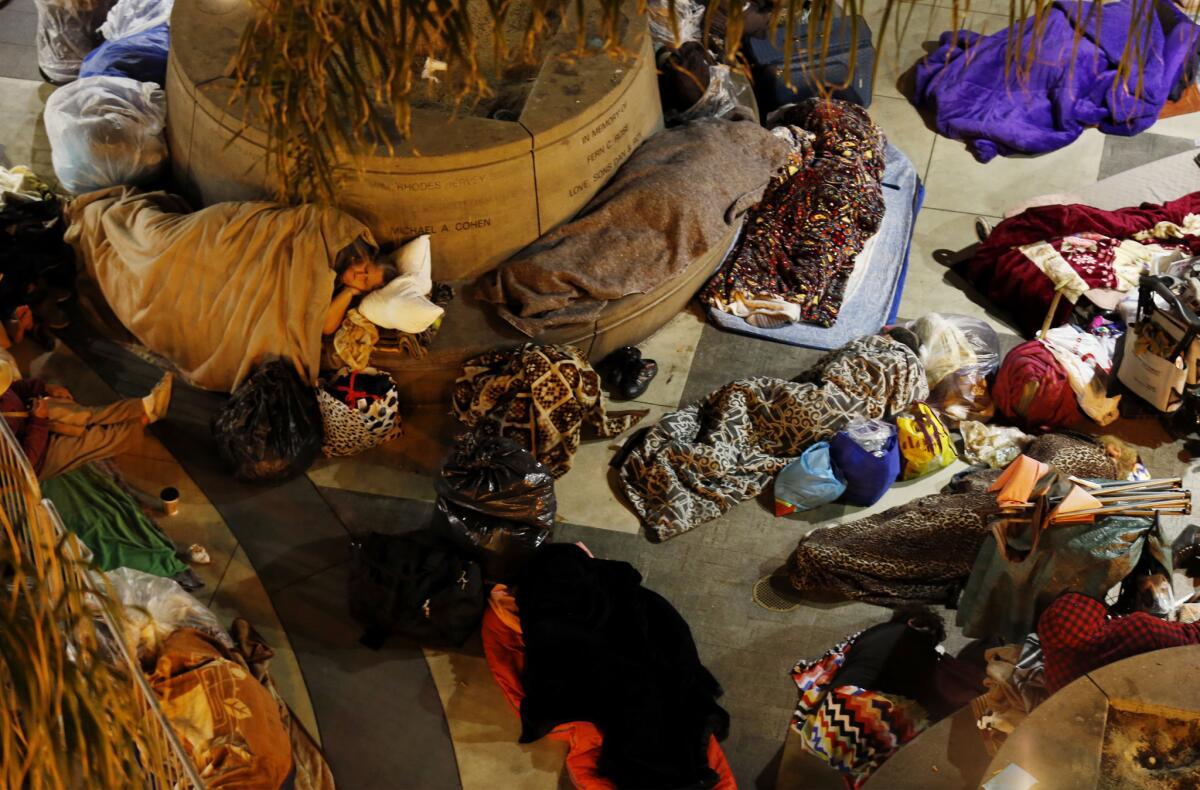
There is no better way to lose the war than for one community after another to shun responsibility and foist social and economic failures onto someone else.
In Santa Ana, about 1,000 homeless people have just been rousted from their camps along the river, but there is nowhere to house and rehabilitate the majority of them, so they will simply end up scattered around the region.
Yes, there are drug addicts, dealers and predators on the streets of greater Los Angeles, and no resident or merchant wants lawlessness, trash and disease on their doorstep. But we already have those conditions in hundreds of locations, and the solution is to police the predators while assisting those afflicted by poverty, the scars of combat and the ravages of mental illness and addiction, which often are intertwined.
We know what works in most cases, Mangano said. We know that supportive housing is the best long-term solution, but we continue to bail a sinking boat with a teaspoon.
“We know what to do and how to do it, and that leaves one issue, which is scaling,” said Mangano, who believes government alone cannot meet the challenge. “Of course, the logical place, where the deepest resources are, is the private sector. So we need to mobilize the private sector to join in layering on top of what government can do … to approximate the scaling necessary to respond to the magnitude of the problem.”
Mangano’s pitch is that private financiers can do well and do good at the same, getting a return on their investment while addressing a great social need.
He has been talking up this strategy for years, with support from Garcetti, Ridley-Thomas, Los Angeles City Atty. Mike Feuer and other local officials, and there are models of success. Los Angeles film producer and real estate developer Steve Bing’s construction company has worked with the city’s housing authority, the U.S. Department of Veterans Affairs and nonprofit service providers such as Step Up on Second to convert blighted motels into efficiency apartments for veterans.
“Instead of allowing blighted properties to decay, let’s use them to make powerful change in our communities by giving veterans the access to the services and housing they need and deserve,” Garcetti said in 2016, when the housing authority awarded 400 rent vouchers to the Bing-Step Up venture.
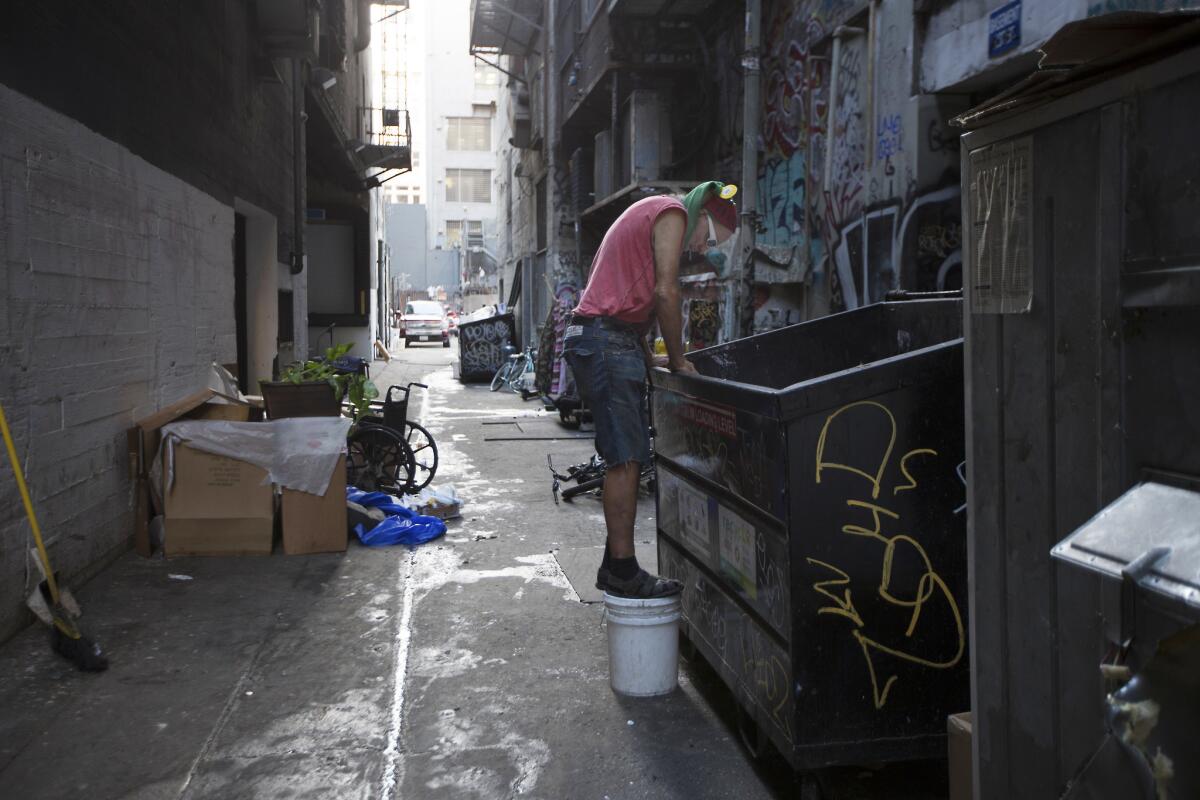
Tod Lipka of Step Up on Second said motel conversions run about half the cost of new affordable housing construction per unit and can be completed in half the time. But progress sometimes gets slowed by the bureaucratic process.
Four recent applications by Step Up for partial HHH funding of motel conversions were rejected by the city’s Housing and Community Investment Department. I met up with Lipka at City Hall, where he contested the decision at a meeting of the HHH citizen oversight committee, whose chair is Santana, the former city administrative officer who spotlighted the city’s inefficient spending on homelessness.
Lipka brought several veterans with him, all of them formerly homeless, and they told me how their lives had been transformed by housing and supportive services provided by Step Up.
The agency’s staff reported that the Step Up applications were rejected because they were incomplete, an assessment Lipka disputed. Santana and others argued that the need for housing is critical and urgent and the staff needs to help applicants meet requirements for approval. Board member Kerry Morrison recommended that the motel conversion applications be approved pending completion of the process, and the vote was unanimous.
“Private investment is not the ultimate answer, but we have to think about how to develop innovative solutions, because what we have now doesn’t create housing quickly enough,” Lipka said. “It can take three to five years to get affordable housing up and running, so we need to … generate housing less expensively or more quickly, or both.”

In recent weeks, Garcetti and other city officials have celebrated the opening of toilets and showers on skid row, and announced plans for 67 temporary housing units in trailers on a downtown city parking lot as a pilot project.
That’s fine, but it’s nothing anyone should be taking bows for as the boat takes on more water.
I’ve been to Venice, where residents step out of their homes and over the blanketed, huddled masses.
I’ve seen Mid-City merchants clear homeless people from the entrances to their shops.
I’ve seen homeless colonies on the shores of the L.A. River, where storm drains are toilets and people bathe in the water.
I’ve seen San Fernando Valley parks with more sleeping bags than kids at play.
I’ve seen veterans asleep at the gates of the VA property in Westwood.
I’ve been to skid row and to Hollywood with a doctor and social worker who share notes on who among the most desperately ill might die next before help arrives.
This is not a disaster movie, nor a dystopian dream in which rules and social contracts do not apply.
This is real.
This is Los Angeles.
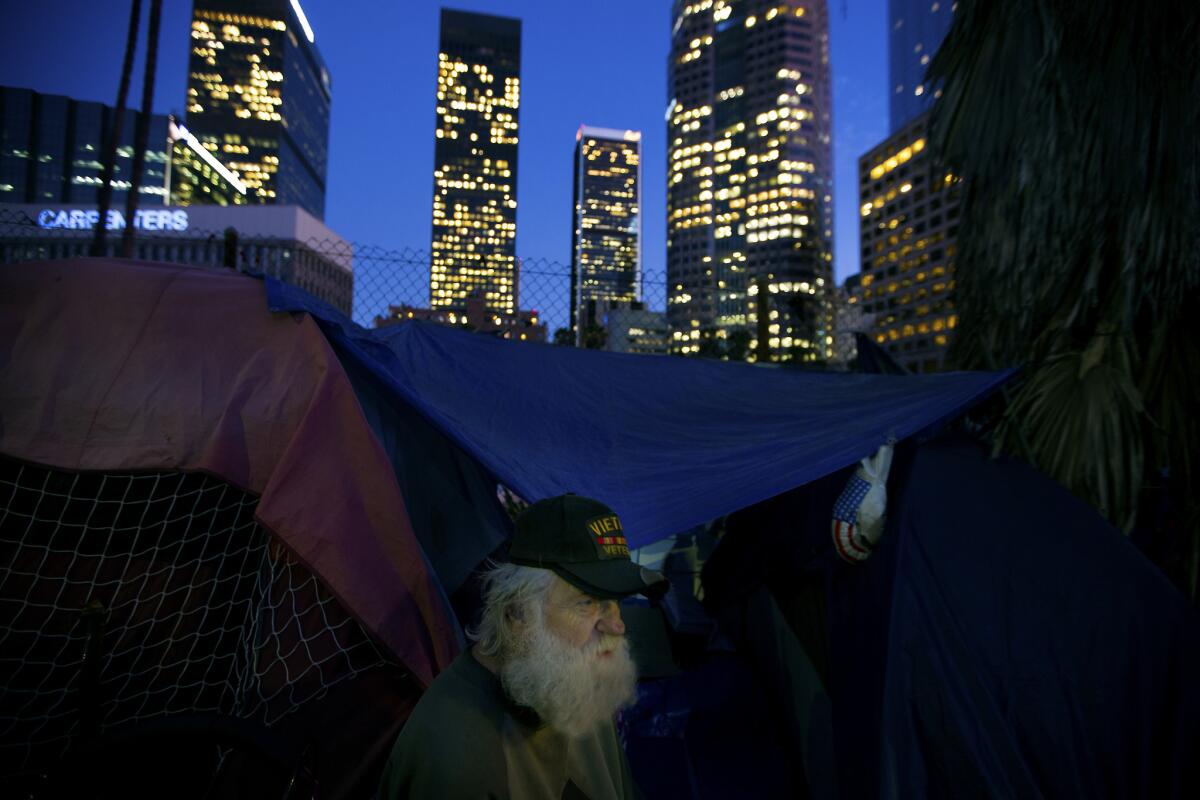
Former Mayor Jim Hahn once told me that as a kid, he went on rides with his dad, Supervisor Kenneth Hahn, and his job was to look for potholes that needed to be fixed.
If I were king for a day, I’d demand that every council member and supervisor do the same with homeless encampments, and report back monthly, with details about who’s living in them and a plan to get them off the streets.
I’d be on the phone to faith leaders and ask why, 18 months into the foot-dragging over a plan to copy a highly successful program in Santa Barbara, nobody has stepped up to offer church parking lots as safe overnight havens for people living in their cars.
I’d visit every proposed affordable housing site where residents stand in the way, and explain why that’s short-sighted and maybe even more costly in the long run.
I’d be ashamed of the fact that a few blocks from City Hall, you can find 31 tents on one street, and I’d explain what I intended to do about it.
Getting people off the street is not easy in every case, and I know this from personal experience, having worked for an entire year with the help of mental health professionals to bring a friend indoors.
But we’re not trying hard enough, and that goes for every City Council member and every county supervisor, and for every resident who says fix this problem, but whatever you do, don’t let them get back on their feet in my neighborhood.
At the kickoff for the latest homeless count, Garcetti offered his take on what’s possible.
“We can cut this problem in half in five years,” he said. “And in 10 years…we can end life on the street.”
It sounded very familiar.
Get more of Steve Lopez’s work and follow him on Twitter @LATstevelopez
More to Read
Sign up for Essential California
The most important California stories and recommendations in your inbox every morning.
You may occasionally receive promotional content from the Los Angeles Times.














